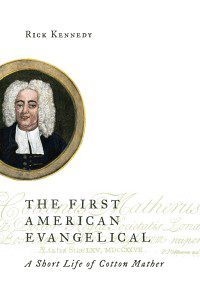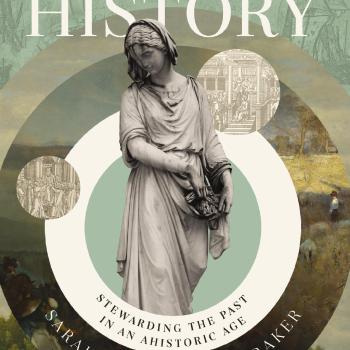“Nebuchadnezzar’s malady was not unlike a lycanthropy,” wrote Cotton Mather in his Biblia Americana.
The Book of Daniel informs that the king of Babylon and conqueror of Jerusalem lived as a beast. He grew claws and feather-like hair. How? God smote him. Was this a disease of the mind? Mather noted passages in the gospels in which people act like animals, and he allowed that he himself had seen possessed persons “bark like dogs, mew like cats, clack like a fowl, and have manners like those of beasts.” Nebuchadnezzar, however, had been afflicted in body as well as mind. Mather added that the Greek story of Zeus turning Lycaon into a wolf might have derived from the biblical narrative.
The Bible describes a world of wonders, centered on a God and other heavenly beings who actively intervene in the world. God sends blessings and curses. God speaks to men and women. Angels appear as strangers in their midst. Satan deceives unwary souls.
 In his The First American Evangelical, Rick Kennedy explains that New Englander Protestants at the turn of the eighteenth century argued among themselves about the extent to which they still lived in a world of wonders. It was the dawn of the Enlightenment. Ministers such as Cotton Mather eagerly devoured new scientific information, wrestling with the advent of biblical criticism, and promoting humanitarianism. Such developments raised a basic question: did God still interact with his creation as he had done long ago? And did angels ? And did Satan?
In his The First American Evangelical, Rick Kennedy explains that New Englander Protestants at the turn of the eighteenth century argued among themselves about the extent to which they still lived in a world of wonders. It was the dawn of the Enlightenment. Ministers such as Cotton Mather eagerly devoured new scientific information, wrestling with the advent of biblical criticism, and promoting humanitarianism. Such developments raised a basic question: did God still interact with his creation as he had done long ago? And did angels ? And did Satan?
Mather answered those questions with an emphatic yes:
Cotton Mather found no warrant for believing God had calmed down. As a pastor who also served as a medical doctor, Cotton knew too much about the lives of people around him to think that God was no longer wildly active in and around New England. Cotton lived, preached, and published the biblical picture of a creation where the spiritual and physical intertwined. He and his church had experienced demon possessions, levitations, and angelic visits.
Others answered no. Miracles had ceased. God had used such means of communicating with human beings when human civilization was in its infancy, but no more.
Many New Englanders fell somewhere in between these two positions (of the two, a strict cessationism was uncommon). Perhaps God and angels did on occasion intervene in the world or appear to individuals. It was most rational, though, to respond with skepticism to claims of divine or angelic voices.
Kennedy uses this basic question to get at the disintegration of New England Puritanism into competing religious interests. Most New England Congregationalists felt an attachment to what they termed the “Protestant interest” (as chronicled in my co-blogger Thomas Kidd’s book of that name), the cause of British Protestantism under threat from Catholics and Indians alike. Beyond that, though, New England unity had frayed. Some New England Protestants, such as Mather’s foil Thomas Brattle (a prosperous and well-connected Boston merchant), cultivated a genteel sort of genteel, moderate, restrained Protestantism. They mocked claims of demonic possession, levitation, and angelic visits.
By contrast, there was nothing restrained about Mather’s brand of Protestantism, which he labeled the “evangelical interest.” Mather believed in an ongoing communication between Christians and God. He prayed while prostrate on his floor, and he prayed while in the latrine. And God listened and responded. And the events that surrounded him — from the deaths of two wives and countless children to the political deliverance of Massachusetts — were the direct results of God’s will.
Rationalists such as Thomas Brattle warned of the dangers of believing too much. “Mather, on the other hand,” explains Kennedy, “was more worried about believing too little.”
If students of U.S. History have heard of Cotton Mather, it is most likely in connection with the Salem Witch Trials, which led to the execution of nineteen individuals. Both Mather and Brattle wrote letters to the judges, and they both believed that the use of “spectral evidence” (reports of what apparitions told individuals) should not be the sole basis for a conviction.
Brattle, though, scoffed at the notion that witches could emit “venomous and malignant particles” from their eyes to afflict their victims. It was “ignorance and folly.” By contrast, according to Kennedy, Mather believed “that the cosmos was wild with both natural laws and miracles.” Jesus walked on water and walked through doors. Perhaps witches could emit dangerous particles from their eyes. Mather did not necessarily think people should be killed on the basis of such claims, though he did preach a sermon at one such execution. At the same time, should one simply discount testimony of the supernatural? Mather and his wife believed in the reality of Satan and witchcraft. They had taken afflicted young women into their home and shepherded them through what they understood as spiritual healing.
Kennedy defends Mather too much at this juncture for my taste. He terms Brattle’s thinking “harsh and boxy,” but at least it was correctly harsh and boxy. Claims about God’s activities in the world are sometimes dangerous. From my vantage point at least, claims about Satan’s workings usually are. Of course, Brattle was unusual in his thorough-going rejection of the supernatural as a reasonable explanation for current events. Kennedy frames their points of view as a rationalist belief in the infallibility of reason and science versus a “reasonable” belief (allowing for a large dose of mystery) in the infallibility of God’s word.
Brattle, it is worth mentioning, did not call everything correctly. In the face of considerable opposition by Battle and many others (including a bomb tossed into Mather’s study that failed to ignite), Mather inoculated Bostonians against small-pox epidemics.
That is just a taste of the compelling material packed into this slender volume. Mather (grandson of John Cotton and son of Increase Mather) overcame a stutter, survived the deaths of many loved ones, wrote prolifically, sent boxes of books to frontier ministers, and loved to sing. Most of all, he believed himself to be following the divine command to “Eat this book!” Students of American religious history will enjoy digesting The First American Evangelical.












